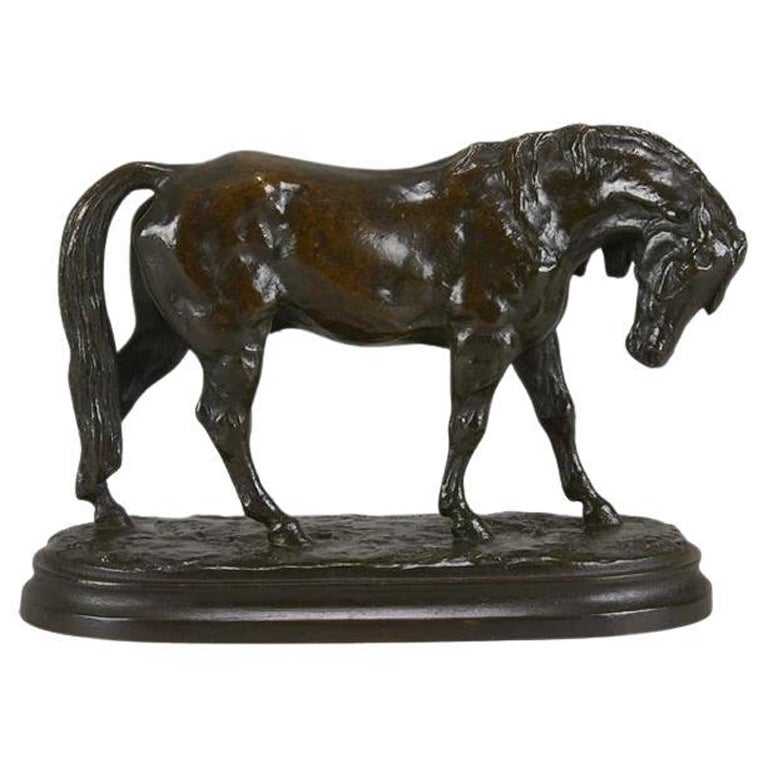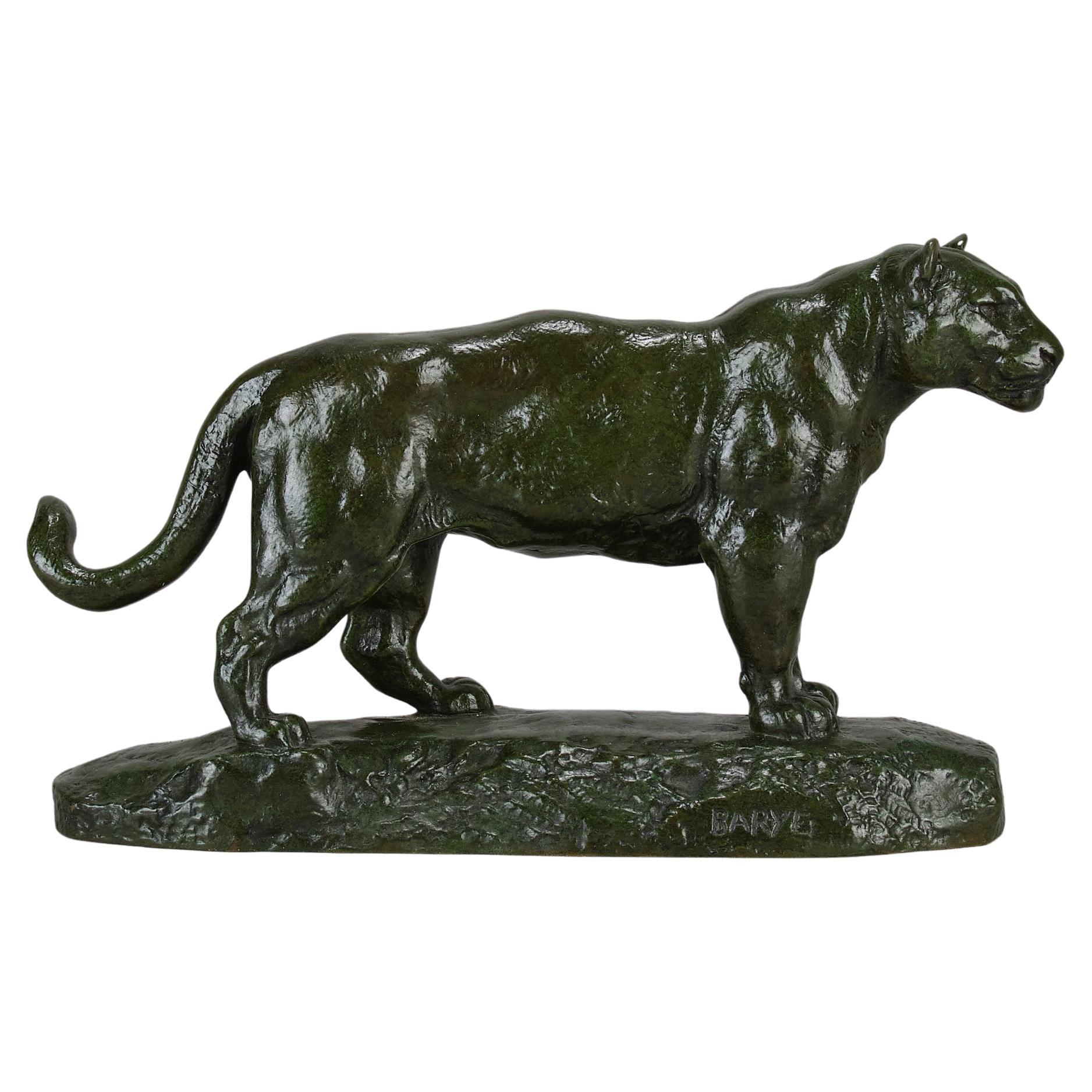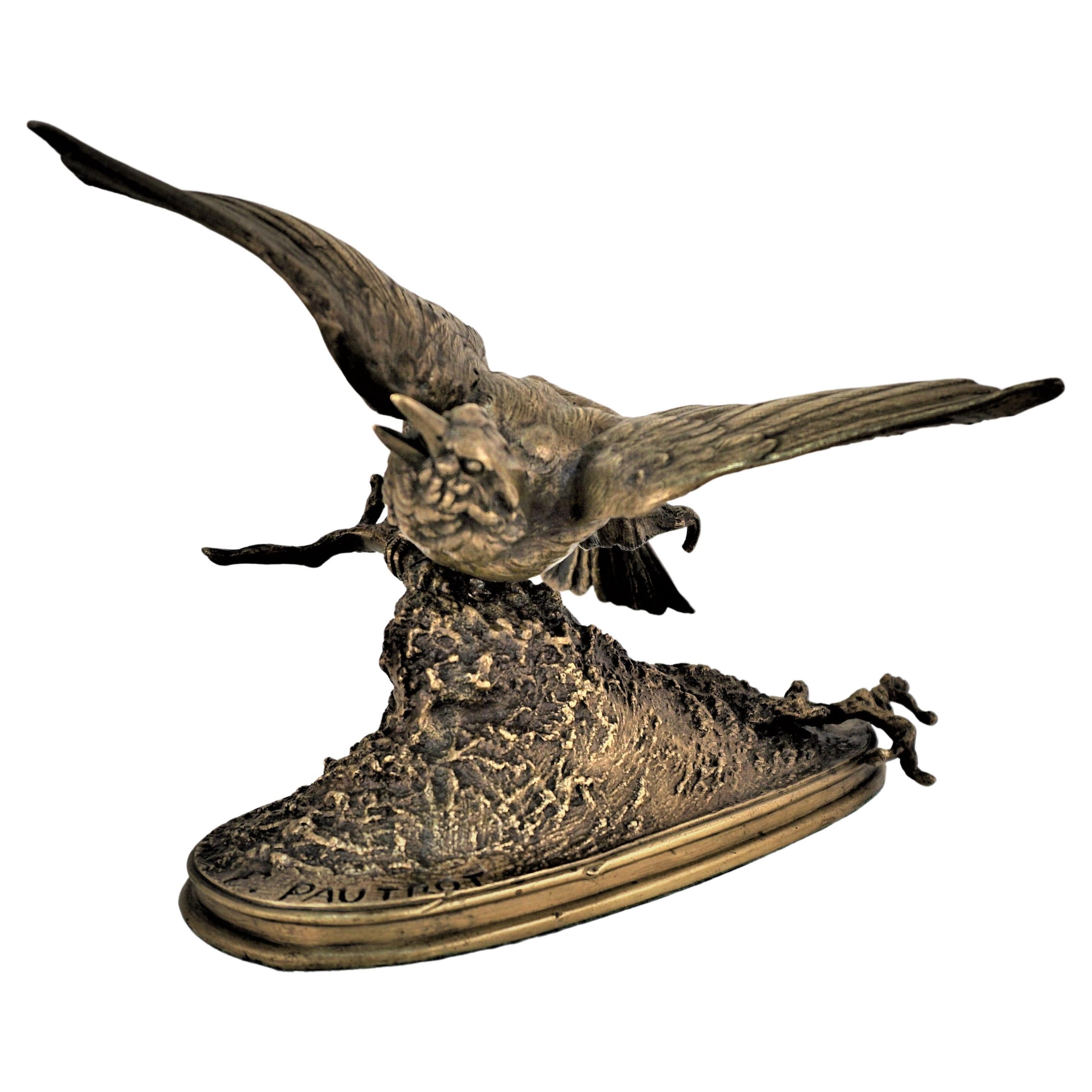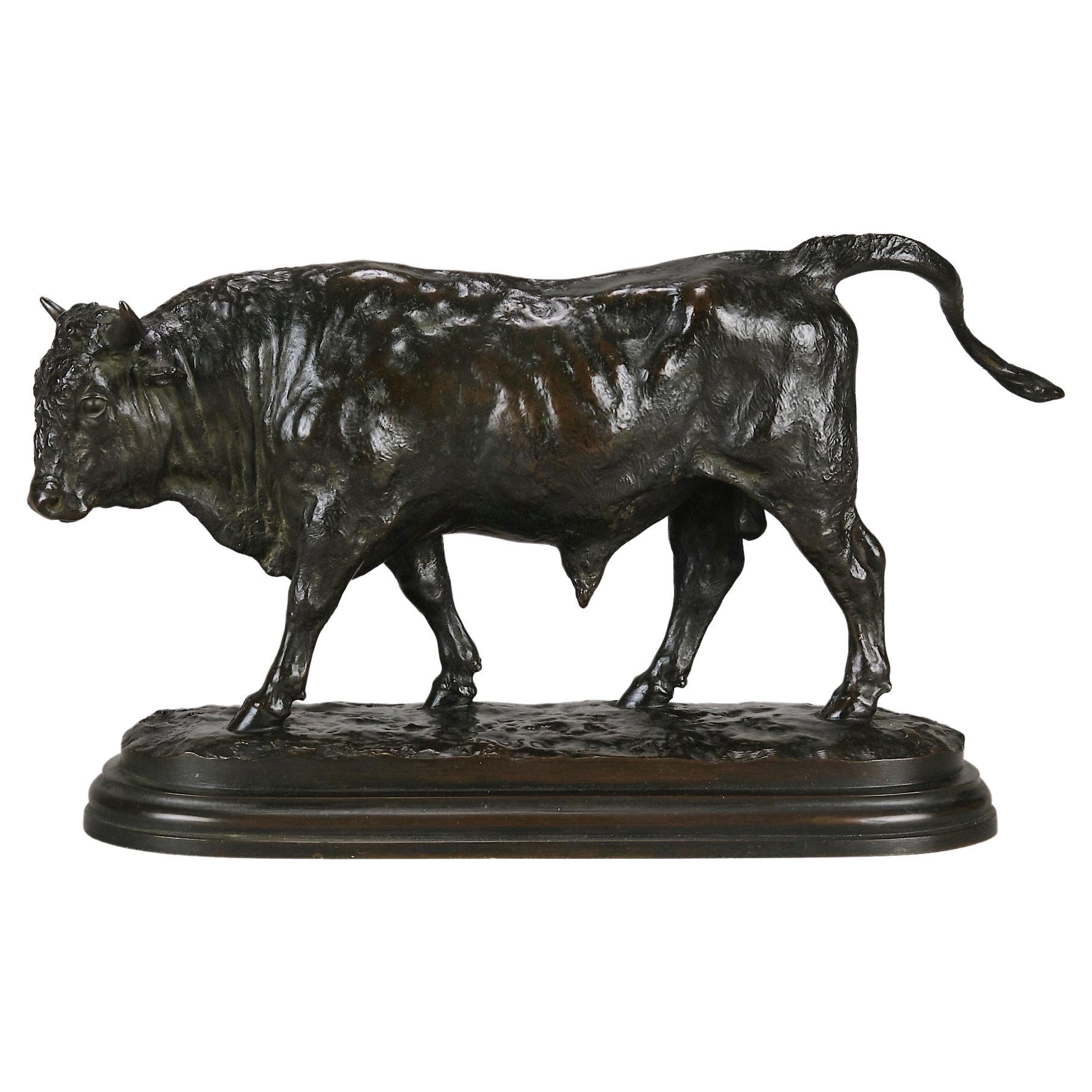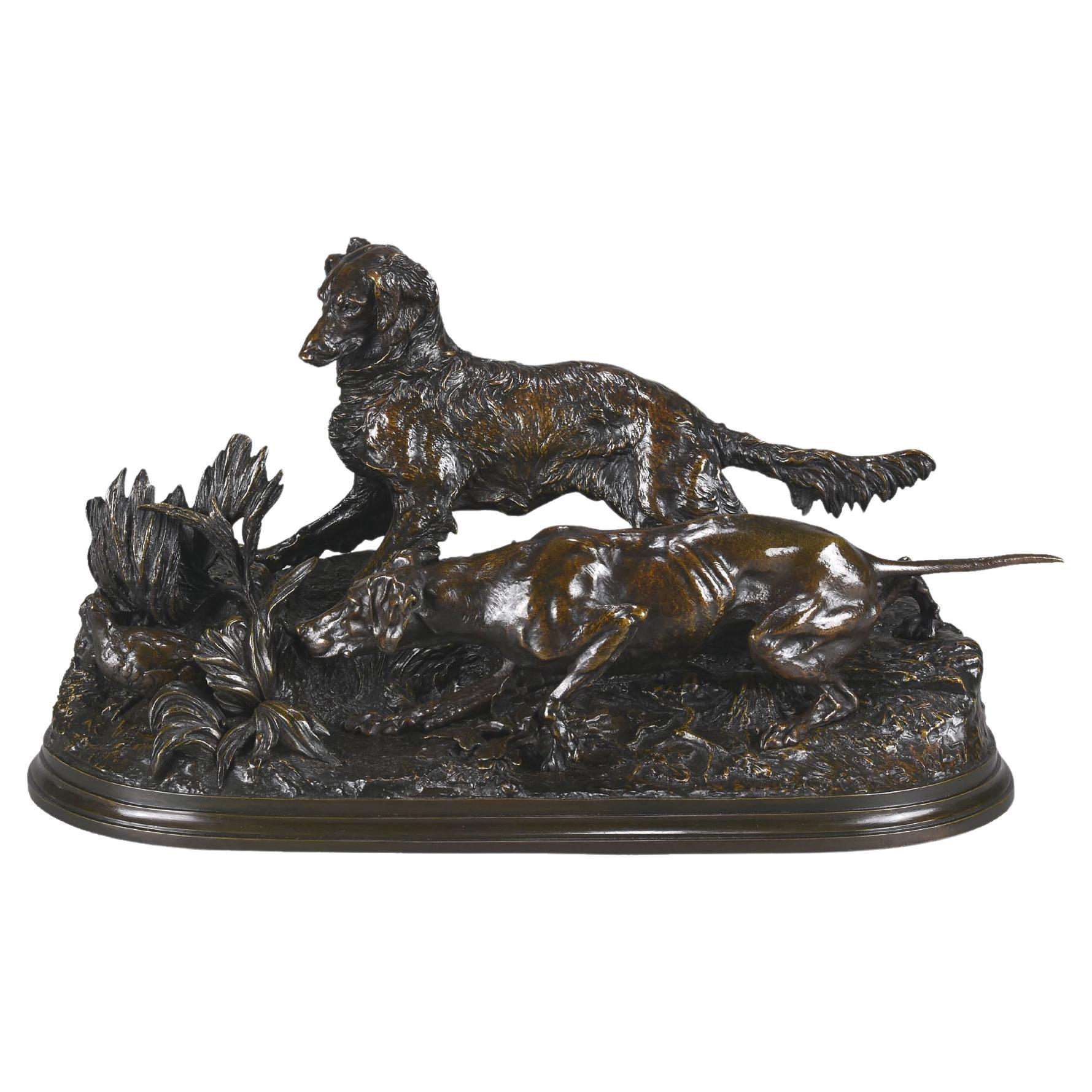Items Similar to Animalier Bronze Study Entitled 'Faisan Debout' by Ferdinand Pautrot
Want more images or videos?
Request additional images or videos from the seller
1 of 10
Animalier Bronze Study Entitled 'Faisan Debout' by Ferdinand Pautrot
About the Item
Very fine 19th Century French Animaliers bronze study of a standing pheasant raised on a naturalistic base with rich dark brown patina and intricate surface detail, signed Pautrot and inscribed Paris 1870
ADDITIONAL INFORMATION
Height: 25 cm
Width: 40 cm
Depth: 16 cm
Condition: Excellent Original Condition
Circa: 1870
Materials: Bronze
Book Ref Les Animaliers by Jane Horswell
Page no. 277
SKU: 4678
ABOUT
Ferdinand Pautrot (French, 1832 ~ 1874) Pautrot was born in Poitiers, France. Very little is known about this competent French sculptor. His first recorded exhibit was at the Salon in Paris in 1861 with three entries. He continued to exhibit at the Salon until 1870. His works consist of mostly hunting dogs, birds, and a few horses and wild animals. Pautrot’s works are highly detailed and accurate in the portrayal of his subjects.
- Creator:Ferdinand Pautrot (Sculptor)
- Dimensions:Height: 9.85 in (25 cm)Width: 15.75 in (40 cm)Depth: 6.3 in (16 cm)
- Style:Other (Of the Period)
- Materials and Techniques:Bronze,Cast
- Place of Origin:
- Period:
- Date of Manufacture:1870
- Condition:Wear consistent with age and use. Excellent Original Condition Please note that our items are genuine antiques with considerable age. It is therefore normal that they will show some signs of wear and handling to the surface.
- Seller Location:London, GB
- Reference Number:
About the Seller
5.0
Gold Seller
These expertly vetted sellers are highly rated and consistently exceed customer expectations.
Established in 1936
1stDibs seller since 2017
63 sales on 1stDibs
Typical response time: <1 hour
- ShippingRetrieving quote...Ships From: London, United Kingdom
- Return PolicyA return for this item may be initiated within 10 days of delivery.
More From This SellerView All
- French Animalier Bronze Study Entitled "Setter & Game" by Ferdinand PautrotBy Ferdinand PautrotLocated in London, GBExcellent quality late 19th Century French bronze Animalier study of a seated setter holding a game bird in its mouth, with exquisite hand chased surface det...Category
Antique 1870s French Other Animal Sculptures
MaterialsBronze
- French Animalier Bronze Study Entitled 'Cheval Debout' by Isidore BonheurBy Isidore Jules BonheurLocated in London, GBFabulous late 19th Century French Animalier bronze study of a standing horse with wonderful rich dark brown lightly rubbed to mid/golden brown patina and excellent crisp surface detail, raised on a stepped integral base, signed I Bonheur ADDITIONAL INFORMATION Height: 13 cm Length: 19 cm Condition: Excellent Original Condition Circa: 1870 Materials: Bronze Book Ref Animals in Bronze by Christopher Payne Kjellberg Page no. 177 SKU: 8526 DESCRIPTION Isidore Bonheur Bonheur Cheval– Isidore Bonheur (1827 ~ 1901) was born on May 15th 1827 in Bordeaux, France, and died in Paris in 1901. He was an important Animalier sculptor, the brother of Rosa Bonheur, and brother-in-law to Hippolyte Peyrol the founder. The Bonheurs were a well known family of painters, sculptors and artists. Isidore studied painting under the tutelage of his father at a very early age. He moved on to sculpture in 1848 with his first Salon entry of a plaster study of An African Horseman attacked by a lion. Isidore Bonheur continued exhibiting his sculpture throughout the years, both at the Salon in Paris as well as the Royal Academy in London. He won medals at the Salon in 1865 and 1869, and won the Gold Medal at the Paris Exposition Universelle of 1889. Bonheur was awarded the Legion of Honneur in 1895. Isidore Bonheur’s bronzes range from domestic cattle and sheep, which he excelled at, to wild bears and lions as well as equestrian and hunting groups, all done in a very natural and realistic manner. His Le Grand Jockey...Category
Antique Late 19th Century French Victorian Animal Sculptures
MaterialsBronze
- 19th Century Animalier Bronze Study entitled "Jaguar Debout" by Antoine L BaryeBy Antoine-Louis BaryeLocated in London, GBAn impressive late 19th Century Animalier bronze study of a standing panther with excellent rich green patina and very fine hand chased surface detail. Raised on an integral base, si...Category
Antique Late 19th Century French Art Nouveau Animal Sculptures
MaterialsBronze
- 19th Century Animalier French Bronze Entitled "Taureau Debout" by Rosa BonheurBy Rosa BonheurLocated in London, GB"Taureau Debout" by Rosa Bonheur. An excellent late 19th Century French animalier bronze study of a standing bull with fine hand chased surface that accentuates the muscle definition of the subject, signed Rosa B. ADDITIONAL INFORMATION Measures: Width: 32 cm Height: 18 cm Depth: 11cm Condition: Excellent Original Condition Circa: 1870 Materials: Bronze Book reference: Animals in Bronze by Christopher Payne Page no. 174 DESCRIPTION Bonheur, Rosa (1822-1899) The most popular artist of nineteenth-century France, Rosa Bonheur was also one of the first renowned painters of animals and the first woman awarded the Grand Cross by the French Legion of Honor. A professional artist with a successful career, Bonheur lived in two consecutive committed relationships with women. Born on March 16, 1822 in Bordeaux, Marie Rosalie Bonheur was the oldest of the four children of Raimond Oscar Bonheur (1796-1849) and Sophie Marquis. Bonheur's father was an art teacher who came from a poor family, while her mother, a musician, had descended from a middle-class family and had been her husband's art student. Bonheur's father, who taught drawing and landscape painting, was an ardent member of the utopian Saint Simeon society. The group held idealistic beliefs about the reform of work, property, marriage, and the role of women in society. Most importantly, for the artist's future, the Saint Simeons questioned traditional gender norms and firmly believed in the equality of women. While teaching artistic techniques to his oldest daughter, Raimond Bonheur also encouraged her independence and taught her to consider art as a career. In 1828 Raimond Bonheur joined the Saint Simeons at their retreat outside Paris. Sophie and the children joined him in Paris the following year. Four years later, however, Raimond abandoned his family to live in isolation with his fellow Saint Simeons. Sophie Bonheur died in 1833 at the age of thirty-six. Rosa was only eleven years old when her mother died, but she was aware of the heavy price her mother paid for married life with a man who was more dedicated to his own ideals than to meeting his family's needs. Rosa also saw that her mother's marriage led to poverty and her death from exhaustion. After her mother's death, Bonheur was taken in by the Micas family who resided nearby. Mme Micas and Bonheur's mother had been friends. When Mme Bonheur died, the Micas family paid Raimond Bonheur's debts and cared for Rosa. Their daughther, Nathalie, who would later become an amateur inventor and unschooled veterinarian, and Rosa became enamored with each other. When Rosa Bonheur began her career as a professional artist, she had already been trained by her father who had allowed her to study in all male classes. Rosa also learned by sketching masterworks at the Louvre from the age of fourteen, and later, by studying with Léon Cogniet. From the very beginning, Bonheur's favorite subject was animals. She learned their anatomy completely by dissecting them in local slaughterhouses. She also visited the horse market two times a week. Study of animals by direct observation led to the formation of the realist style in which Bonheur worked. It was for such work that Bonheur obtained written permission from the French government to wear men's slacks. Her working attire also consisted of a loose smock and heavy boots that protected her feet from the dangerous environment in which she painted. The style of dress that the artist adopted for work and home may well have been influenced by her father's attire, which was based on St. Simeonian clothing experiments. Bonheur also cropped her hair, perhaps to facilitate her work. She did, however, always wear dresses for social occasions because she knew that appropriate dress would further her career. Bonheur earned a successful living as a painter of animals. She exhibited at the annual Paris Salon regularly from the age of nineteen in 1841 through 1853, when she was thirty-one. She won the salon's gold medal at the age of twenty-six in 1848 and was commissioned by the French government to paint Plowing on the Nivernais in 1849. In the same year Bonheur and her sister Juliette became directors of l'École gratuite de dessin pour les jeunes filles, a post their father had once held. Bonheur completed her most renowned work, The Horse Fair, in 1855. The successful representation of percherons (a breed native to Normandy) was purchased by Ernest Gambart, a London art dealer whose gallery specialized in work by French artists. He exhibited The Horse Fair in London where Bonheur visited with Nathalie. Queen Victoria requested a private viewing of the painting at Windsor Castle. It would later be purchased in 1887 by Cornelius Vanderbilt and donated to the new Metropolitan Museum of Art in New York City. Bonheur's trip to England allowed her to meet Charles Eastlake, then President of the Royal Academy, John Ruskin, the English writer and critic, and Edwin Landseer, the British animalier. She also toured the English and Scottish countrysides and executed some paintings based on her observations of new breeds of animals found there. Gambart made engravings of Bonheur's work, including The Horse Fair, and sold them in England, Europe, and the United States. Bonheur became one of the most renowned painters of the time. Little girls, such as Anna Klumpke in the United States, even had dolls in her likeness, much as American girls played with Shirley Temple dolls...Category
Antique 19th Century French Art Nouveau Animal Sculptures
MaterialsBronze
- Animalier Bronze Study Entitled 'Chasse à la Perdrix' by Pierre-Jules MêneBy Pierre Jules MêneLocated in London, GBA fabulous Mid-19th Century French animalier bronze study of two hunting hounds, a setter and a pointer, flushing a partridge in the undergrowth. The bronze with very Fine deep brown...Category
Antique 1850s French Other Animal Sculptures
MaterialsBronze
- Late 19th Century Animalier Bronze entitled "Cheval Debout" by Isidore BonheurBy Isidore Jules BonheurLocated in London, GBMagnificent late 19th Century French Animalier bronze study of a standing thoroughbred with rich brown patina and excellent crisp surface detail, raised on a stepped integral base, s...Category
Antique Late 19th Century French Art Nouveau Animal Sculptures
MaterialsBronze
You May Also Like
- Ferdinand Pautrot '1832-1874' 19th Century French Bronze Bird Perched on BranchBy Ferdinand PautrotLocated in Fairfax, VA19th century brown-gold patinated bronze sculpture of bird on a tree stump.Category
Antique 19th Century French Animal Sculptures
MaterialsBronze
- 19th Century French Patinated Bronze Pheasant Sculpture Signed F. PautrotBy Ferdinand PautrotLocated in Dallas, TXAccessorize a man's office or desk with this elegant antique bronze bird composition. Crafted in France circa 1895, the avian sculpture features a pheasant standing on rocky ground c...Category
Antique Late 19th Century French Animal Sculptures
MaterialsBronze
- 19th Century Bronze Statue of Dogs Hunting Grouse Signed F. PautrotBy Ferdinand PautrotLocated in Dublin 8, IE19th Century bronze statue of a pointer and spaniel hunting grouse with signature of F. Pautrot. Ferdinand Pautrot’s (French, 1832-1874) first recorded exhibit was at the Salon in P...Category
Antique Late 19th Century Animal Sculptures
MaterialsBronze
- French Cubist Bronze by Ferdinand ParpanBy Ferdinand ParpanLocated in Bridgewater, CTFerdinand Parpan (1902-2004) "St. Francis", a black patinated cubist bronze on rouge marble base, signed, monogrammed and dated 1950 in the bronze. Mea...Category
Vintage 1950s French Art Deco Sculptures
MaterialsMarble, Bronze
- Animalier Bronze of a Pointer by Jules MoingiezBy Jules MoigniezLocated in London, GBSuperb antique patinated bronze model of a pointer by Jules Moingiez. Outstanding cast and in pristine condition this shows a pointer at work in a most skillful way. The pointer aler...Category
Antique 1880s French Animal Sculptures
MaterialsBronze
- Iconic Animalier Bronze Sculpture by Hippolyte HeizlerBy Hippolyte HeizlerLocated in Bochum, NRWHippolyte Heizler (1828–1871). Two dogs standing in front of a hare hiding under the leaves. Large bronze statuette with brown medal patina. Molded oval base. Signed on the base "Heizler", foundry mark lower back Société des Bronzes de Paris...Category
Antique 19th Century French Animal Sculptures
MaterialsBronze
Recently Viewed
View AllMore Ways To Browse
Antique Study Furniture
Entry Sculpture
Bronze Pages
Animalier Sculpture
Animalier Sculptures
Animalier Sculpture Bronze
French Animalier Sculpture
Animalier Bronze
French Animalier Bronze
Hunting Dogs
Animaller Bronze Study Horses
Bronze Hunting
Bronze Horse Sculpture Original
Antique Bronze Dogs
19th Century Animalier Bronze
Little Dogs
Bronze Sculpture Hunting
Gold Pheasant

